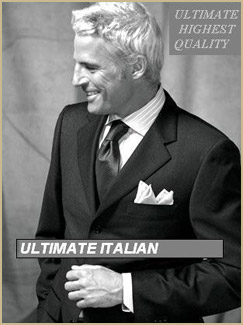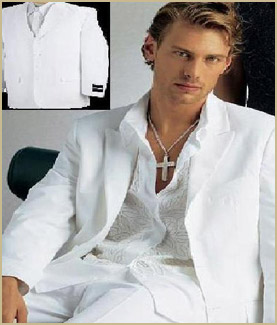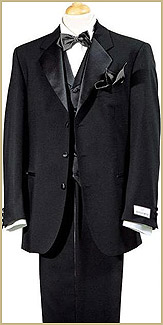A suit is generally
worn with the intention of making a statement about oneself,
create a certain image or simply as an expression of respect.
In the corporate world a business suit can convey the individual’s
place within the organization’s hierarchy,  establish
power and position and express one’s proficiency and mastery
in his profession. A suit is usually the garment of choice to
show respect in special circumstances whether at a wedding,
funeral, graduation or other life cycle event. Following are
some tips on purchasing a suit.
What is super 150’s WOOL?
Super 150's Wool = You can probably guess !!!
Yet, even softer Than super 100’s and 120’s. Here you are talking
about "Celebrity Status." I'm sure by now, you can
probably guess how many threads there are per inch ... yep,
150 threads per inch. Here is where you start getting into high-quality.
The thread of this story is the numbering system used to describe
the new breed of super-lightweight, high-twist wools. Pioneered
by Italian mills about ten years ago, these fabrics are made
using high-tech machines that spin wool lighter and finer than
it's ever been spun before. The various grades of cloth are
referred to as Super 100s, Super 120s, Super 150s.
Why Super Fabrics?
The difference between a Super 150's Wool and a Standard Worsted
Wool is that the wool in a Super 150's Series is softer, higher
quality, and lies just a little nicer on the contours of your
body. Your Super 150's Series is named appropriately because
it contains 150 threads per square inch. If your budget allows,
we highly recommend seeking a Super 150's Series wool or SUPER
120’S.
Firstly, consider the purpose of your suit. Are
you a business executive that wears a suit several times a week?
If so, examine your current suit inventory. Discount those that
you seldom wear and establish the colors, designs and styles
that you are lacking. Remember that dark suits exude power and
authority that are amplified by a pin stripe. These are great
suits for presentations, differentiating oneself in the boardroom
and demonstrating that you are the authority and leader within
the group. Next time you are at a meeting, try wearing a dark
blue, black or charcoal suit with a pin stripe, place yourself
prominently at the head of the table, stand with authority when
you speak and monitor the attitude of your colleagues towards
you.
Need a business suit that says you are one of the guys? Consider
a mid grey suit as first choice followed by taupe and green
shades. Beiges are great in the spring and summer months. Consider
patterns with soft stripes, checks and various fabric textures.
In all circumstances be sure to buy a suit that will fit into
to your environment and not single you out as a tasteless dresser.  Need an interview suit?
Need an interview suit?The most important
advice that we can give you is do not let your clothing
make the lasting impression on your prospective
employer. That impression should be transmitted by your
skills and attributes. An interview suit should be well
tailored, enhance your appearance but not make a
statement on its own. A suit that is memorable to the
interviewer is usually so because it is inappropriate
for one of many reasons; poorly tailored, inappropriate
color or design, bad fit, poorly coordinated etc. For
entry to mid level positions consider wearing a suit in
mid to dark grey or navy shades. For senior management
positions wear a dark grey or navy suit – stripes are an
excellent choice. Remember the accessories are an
important part of the clothing package.
Those of us who wear suits infrequently and need an all
purpose suit should consider navy, grey or black. These
suits can be worn very comfortably to most life cycle
events (weddings, funerals, confirmations, graduations…)
as well as interviews, parties etc. The advantage of
solid navy or black is that the jacket can generally be
worn as a blazer with a matching pant in grey or taupe.
If you have one or two suits in your wardrobe choose
timeless classics that will always be fashionable and
won’t be remembered as the suit you wore the last time
and the time before that and...
Q. Which buttons do I button on my suit jacket?
A. Suits are available now in 1 button, 2 button, 3
button, 4 button, 6 button and more! So which do you
button? Unless it’s a 1-button suit, never, ever, button
the bottom button. This is just for decoration. The
bottom button is too low on your hip to button properly
without making the jacket buckle and make it difficult
to walk.
On a 2-button suit button only
the top button. On a 3-button suit button the
top 2 or the middle 1 (Resist all temptation to button just
the top button or risk arrest by the fashion police). On a 4-button suit button the
top 3 or the middle 2. 6 or more buttons? Either leave
the coat open or button all but the lower buttons placed where
the coat begins to flair out near your hips.
Business Formal
- Black or navy suit with a slight sheen or tone on tone.
- White, cream or pale blue shirt preferable with French cuffs
- Never, never wear short sleeves or button down collars.
- Tie with small pattern or plain, tastefully coordinated.
- Well shined black leather shoes with coordinated black leather
belt.
- Jewellery that is elegant and not ostentatious.
Authoritative
- Navy, black or charcoal suit preferably with a fine pin stripe
- Double breasted presents itself as the ultimate in authoritative,
power look.
- White or light coloured pastel shirt. If the suit is plain
wear a striped shirt.
- French cuff - very appropriate. Never wear short sleeves or
button down collars.
 -
Strongly constrasting tie; plain, small pattern or stripe. No
picture or large design!!!
- Well shined black leather shoes with coordinated black leather
belt.
- Jewellery that is elegant and not ostentatious.
- Season appropriate suit, sport
Corporate Dress
jacket or blazer and pant.
- Medium to light coloured shirt with a suit, dark blazer or
sport jacket. Button down collars are fine.
- Coordinated tie.
- Dark shoes well polished with matching belt.
- Tasteful jewellery that is not ostentatious.
Business Casual
- Sport jacket or blazer and dress pant or softly structured
suit.
- Consider wool, microfibre or even silk. Textured fabrics are
great.
- Patch pockets as a nice casual touch.
- Knit top or open collared shirt. T-shirts not a great idea.
- Long sleeves are best.
- Leather shoes with coordinated belt. Athletic shoes, boat
shoes, etc... not acceptable.
- Tasteful jewellery that is not ostentatious.
Casual
- Semi casual slacks with a pressed crease in wool, microfibre,
cotton or cotton blend.
- Knit top or open collared shirt. T-shirts not a reat idea.
- Long sleeves are best
- Leather shoes with coordinated belt.Athletic shoes, boat shoes,
etc... not acceptable.
- Tasteful jewellery that is not ostentatious
Q. Pleats or flat front?
A. Pleats are more comfortable, flat fronts are more sleek.
Generally we are seeing younger customers begin to try flat
fronts, often with a 2 button side vent suit. The majority of
men are sticking with pleated front slacks. Forget about 3 and
4 pleat models, stick with 1 or 2 pleats.
Q. Cuffs or plain hem?
A. Pleats = cuff (generally 1.75”), Flat front = straight hem.
Exceptions: Tuxedos Never, Ever cuff a formal pant (fashion
police will arrest you and throw out the key!). Pleated pants
may be finished with a plain cuff, however, they balance out
better and hang better with the extra weight of the pant cuff. |